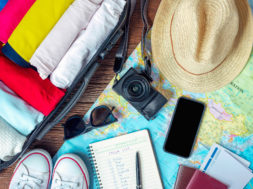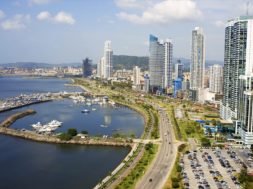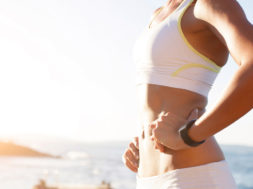This is what I consider to be essential items for any traveler/backpacker. These are items that I have used in my past travels, and have served me well.
Backpack
The first most obvious thing for any traveler to decide on is whether to use a backpack or a suitcase. During my first solo travel experience in Southeast Asia, Korea, and Japan, I traveled with a backpack. For under 50 I bought a Eurohike 55-liter backpack with a rain cover, which came in handy during the monsoon season! The pack was top-opening and didn’t really offer much by way of security. I, therefore, bought a special backpack transit case which I put my backpack into and made it secure from theft, but also made it secure from airport conveyor belts. I had heard that the conveyors in airports sometimes broke clips from backpacks if they were not properly secured and that some airlines didn’t even want to have backpacks on their airplanes because they were a safety threat. I actually lost the backpack case during the course of my travels and had to resort to wrapping my backpack in black bin bags and tape in order to prevent the clips from catching airport conveyors. The backpack was comfortable, with some very nice cushioned padding. However, I realized as my trip went on that the pack was a little too large. I had read on many different websites that the smaller and lighter your pack, the more comfortable your trip will be. This is so true. It is not just about how light the pack is for you to carry, but also practical reasons like traveling on packed trains and subways with a giant wardrobe on your back. The backpack was incredibly annoying whilst traveling on busy subways, as I didn’t know if, and how badly, I was bumping into people – but I am sure that I definitely was! However, it was great to have my hands free when I needed to pay for tickets and also carry bags and water bottles.
Suitcase
On my second trip to Japan, I decided to ditch the backpack and travel with a medium-sized suitcase. I was traveling for 3 weeks and had planned to move around the country quite a bit. I was worried about the condition of the suitcase’s wheels by the end of the trip, but altogether I preferred the comfort of a nice suitcase. The suitcase takes up the use of your arms, but it does relieve your back. I found time and again that my backpack was becoming too heavy and cumbersome for longer walks; a suitcase, meanwhile, makes walking a pleasure. Trying to find your hotel in the humid and busy conditions of Bangkok with your gigantic backpack is not a pleasant experience. Though going upstairs is a pain with a suitcase, but with a backpack, it is a breeze. This may be important to you as it is best to travel around a Japanese city (and many other Asian cities) via the subway system, and sometimes they have enormous staircases leading to the platforms. The final clincher is that a suitcase makes you look more businesslike and professional; a backpack makes you easily identifiable as a traveler or tourist and makes you stand out far more. If I entered a nice hotel with my backpack, I wouldn’t be given the same service as if I traveled with a suitcase. I believe that backpackers have a bit of a bad name in some countries, as backpackers tend to be younger people who are more prone to loutish behavior due to letting off some steam after finishing university.
Daypack
You don’t want to take your suitcase or backpack with you on your daily walks or excursions, so you need a nice convenient daypack. I actually took a shoulder bag, as it looked more stylish than a small backpack. But be warned, a shoulder bag can give you some irritating neck and shoulder pains if you overpack it with large water bottles or souvenirs. In this instance, a nice mini backpack is better as it transfers the weight evenly on your back and shoulders.
Travel Insurance
I always take out travel insurance as you never know what could happen during your trip. It is always better to be safe than sorry. Medical help abroad could cost you thousands if you do not have the correct insurance, so always read the insurance policy properly. When I search for insurance I always turn to comparison sites, such as moneysupermarket.com. This way you can compare all the different companies offering insurance and their relative policies.
Skype
Skype is a free service that allows you to call anyone in the world (which also has a Skype account) for free. The service is completely free when using the Skype-to-Skype service, and the prices are competitive if you want to call mobile phones or landlines. You can use Skype on your iPod Touch, an actual Skype phone or on your laptop. If you are taking a laptop abroad, you can even use your webcam to make video calls, but if you are not taking a laptop, I found that many internet cafes in Asia had Skype already installed on their computers. Skype also allows you to send instant messages, play games, and even transfer files. All in all, Skype is a great device that you should be made use of whilst traveling.
First Aid Box
I like to take a mini first aid box when I travel. The boxes come in some very nice convenient sizes with everything you could need for your trip. Items can include plasters, antiseptic cream, insect repellent, and various tablets for common travel sicknesses.
Clothing
I will not speak at great lengths on clothing, as I believe this is a personal choice and dependent on different people’s needs. However, I will say that you should always pack light, and think about whether you will ACTUALLY need an item of clothing. Sometimes, I have fallen into the trap of packing far too much clothing ‘just in case’. Whilst traveling in Asia you can always pick up cheap clothing, so there is no need to overpack. The minimum I would take for a month traveling is 3-4 t-shirts, 2 shirts, trousers, two pairs of shorts, swimming shorts, 2 pairs of socks, trainers/sneakers (I would buy some that look formal but are as comfortable as trainers).
Travel Washing Line
I take a small washing line on my trips in case there are not enough places to dry my clothes. If you are packing light, you can just wash your clothes more often, and you will sometimes need a washing line for extra space.
Travel Sink Plug
I used this occasionally when I stayed in hostels. In some budget accommodation, you will not have a sink plug, which makes shaving difficult. The travel plug is therefore recommended if you are considering staying in budget accommodation. Also, even some higher grade hotels have faulty plugs in their bathrooms, so it is generally a good item to take.
Toiletries
As a dandy backpacker, I have a vast array of toiletries. My toiletry bag consists of shavers, moisturizers, sun cream, nail clippers, eyebrow tweezers, aftershaves (which I tend to buy from an airport duty-free), lip balm, deodorant and more!
Rain Mac
If you are traveling anywhere that has a monsoon season then a rain mac is a great idea. Monsoon rain is awesome, and can just take you by surprise and leave you drenched. A little rain mac can be scrunched up into a very small size and can easily be carried in your daypack.
Swiss Army Knife
I sometimes take this on my travels as it has various useful devices: a bottle opener, scissors, toothpick, tweezers, screwdriver heads and numerous knives of varying shape and sizes.
Travel Towels
I recommend taking a large travel towel. These can be folded into an incredibly small size and take very little space in your luggage. They also dry quicker than ordinary towels.
Camera
I really don’t know much about cameras but I definitely know that you will need one on your journey. It’s a way of recording experiences that are not possible in any other way. I just bought an 8-megapixel camera in Bangkok – it has served me well.
Batteries
You will need these for your camera, so make sure you take enough spares from your own country, which tend to be cheaper than whilst abroad.
Mobile Phone
A mobile phone is now a necessary gadget in all parts of life and is very important during your travels. It is a great device to keep in touch with other travelers but is also a safety device if you become lost or in danger. Remember to take your charger though, or it will become useless after a few days.
Backup Sim Card
Just in case you lose the first Sim card you can just take another Sim, which is usually free.
Backup Debit/Credit Card
I would take a backup card just in case I lost my main card. If I lost my main card I could just cancel it and then transfer the money from my main account into my backup account via internet banking.
Pens and Paper
You will occasionally need to write things down, such as directions or contacts, and a pen and paper would be very helpful. I would always travel with a mini pen and small notepad in my daypack so that it was easy to get to. You can always use your mobile phone or iPod Touch for this as well.
Travel Adaptors
Travel adaptors are necessary if you want to charge your iPod or mobile phone. Once you know where you are going, you can find out what converter plug you will need. It will save you from having to search around in your destination country. Some plugs are all-rounders and cover everywhere.
iPod Touch
My iPod Touch has been irreplaceable during my travels. Not only is it great for watching movies, listening to music and playing games whilst waiting for your flight or on long train journeys, it also has practical uses. By downloading free applications via its Wi-Fi capabilities you can turn your iPod Touch into a hotel or hostel finder, a currency exchange service, a travel guide and much more. I also bought a special and inexpensive, earphone and microphone set for my Touch, which allowed me to use Skype wherever I had free Wi-Fi. Actually you can find free Wi-Fi everywhere in Southeast Asia: McDonald’s, Starbucks, shopping malls, hotels, and even airports. However, I surprisingly found that Wi-Fi access is not so easily found in Korea or Japan, and tends not to be free if it is offered.
iPad
I don’t actually own one of these but they just seem to be a large iPod Touch. All the convenience of the iPod Touch is a nice pocket device that is easy to take everywhere it is lost on this device. But maybe I am missing something about it.
Travel Guides
I love to read travel guides and always take them on my trips. My favorite guides have always been DK Eyewitness Travel Guides. I regularly use DK Eyewitness Travel Guides: Thailand, Japan and Rome to name a few. I found them incredibly helpful, but most importantly I loved the focus on culture and historical sites. The guides are wonderfully illustrated, easy to navigate, and the pictures and captions are beautifully presented. In addition, the historical sections are informative, well illustrated and a joy to read. I would also recommend Rough Guides and Lonely Planet, which I have also used in the past.
Money Belt
I originally bought one in order to hide my valuables, but then I just used it to hold my bus/train tickets or small change so that it was easily at hand and I didn’t have to rummage through bags or my pockets. The money belt can be used as just a regular bum bag (fanny pack if you’re American) without valuable items and just left on display rather than inside your clothing. I just used it as an extra convenient pocket





